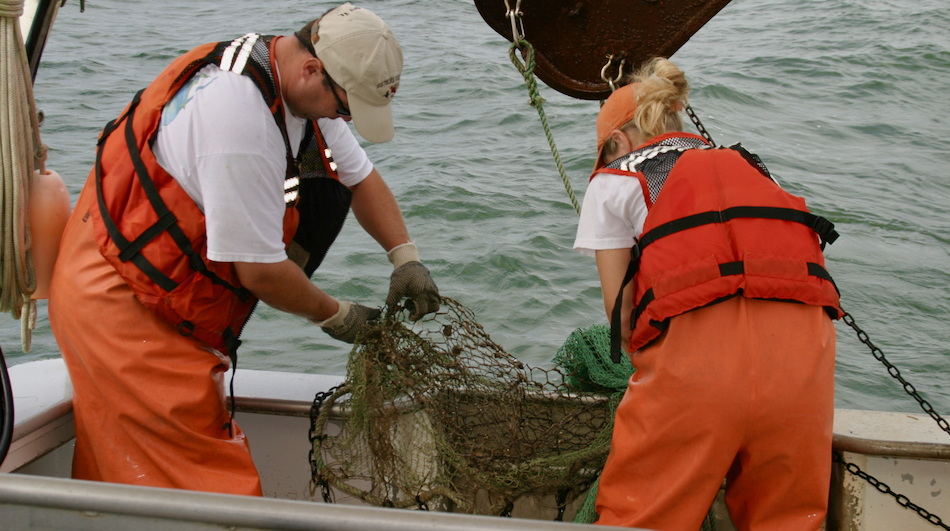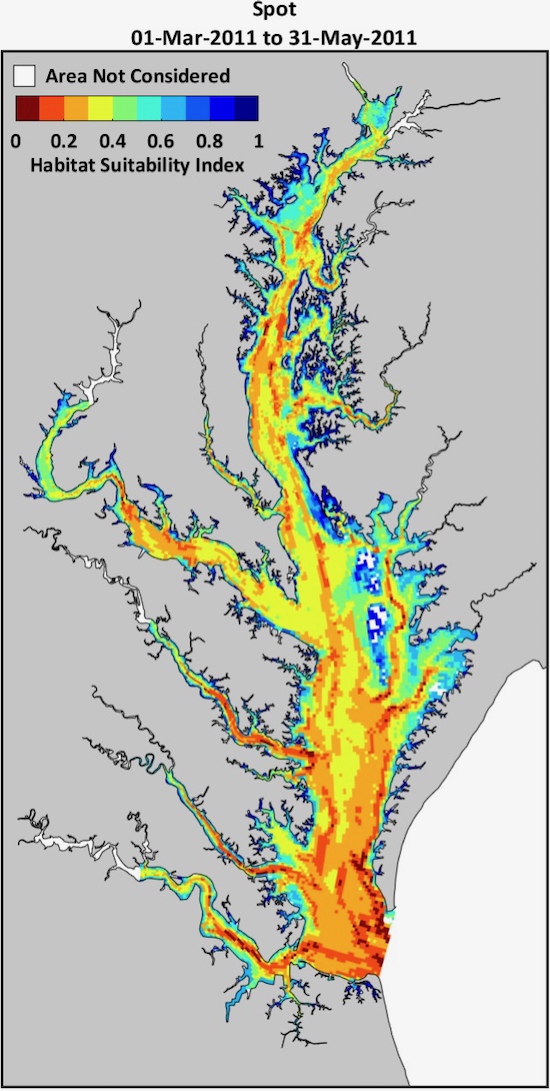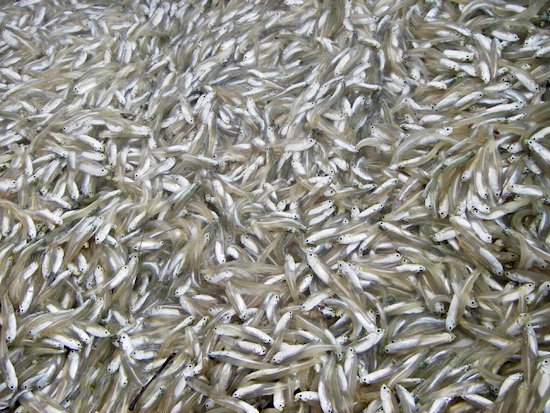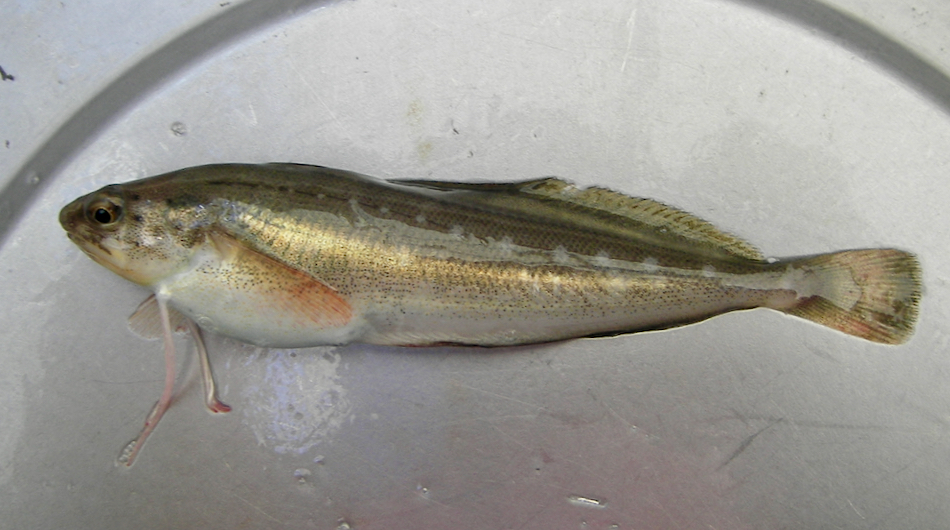Researchers map best conditions for forage fishes in the Chesapeake
Knowledge can guide efforts to restore, protect vital Bay habitats
Big fish eat smaller fish, but only if there are smaller fish to eat. A new study led by researchers at William & Mary’s Virginia Institute of Marine Science maps the conditions most suitable for key species of forage fishes in the Chesapeake Bay, offering guidance for any future efforts to protect or restore the habitat required to yield sufficient prey for predatory fishes such as striped bass.
Lead author on the study, which appears in the October issue of Frontiers in Marine Science, is Dr. Mary Fabrizio, a professor and chair of Fisheries Science at VIMS. Co-authors are fellow VIMS researcher Dr. Troy Tuckey, along with Drs. Aaron Bever and Michael MacWilliams of Anchor QEA, LLC. Bever is a VIMS alum.
“Small fishes such as Bay anchovy are important components of the diets of predatory fishes in Chesapeake Bay,” says Fabrizio, “but factors that affect local abundances of these forage fish have been largely unexplored.”
To throw light on these factors, the research team set out to quantify and map suitable habitats for four common species of forage fishes in Bay waters, and to assess the relationship between habitat extent and fish abundance. In addition to Bay anchovy, the forage species studied were juvenile spot, juvenile spotted hake, and juvenile weakfish.
The team based their study on data generated by counting the number of forage fishes caught in a trawl net during fishery surveys conducted by VIMS and the Maryland Department of Natural Resources between 2000 and 2016. These surveys sample at more than 100 sites throughout the Bay each month. They coupled these catch data with output from computer models simulating the environmental conditions at each sampling site. These conditions include water depth and temperature, salinity, stratification, dissolved-oxygen levels, and current speeds. The researchers also noted whether the bayfloor beneath each net tow was sandy or muddy, and the distance to the nearest shoreline.

The researchers then determined the combination of environmental conditions that most fully explain the observed abundance of each forage species as caught in the survey nets. Their analysis showed that water depth and some measure of current speed exert an influence on the abundance of all species in all seasons; while a temperature factor helped describe suitable habitats for forage fishes in spring, summer, and fall. “Overall,” says Tuckey, “the factors that combined to make a suitable habitat varied among species and ranged between four and seven, depending on species.”
Habitat Suitability Index
The team’s next step was to develop a “habitat suitability index” that ranges between 0 (poor) and 1 (superior), with index values greater than or equal to 0.5 considered “suitable” in subsequent statistical analyses. Feeding these index scores into their computer model revealed in fine detail the seasonal and annual extent of habitats suitable to each species.
 Importantly, data from their 25,000-plus net tows allowed for full calibration and verification of the habitat suitability model, which gave the team confidence they could use it to map suitable forage habitats in areas of the Bay not routinely sampled by fishery surveys, including shallow areas such as Mobjack Bay and tributaries such as the Potomac River.
Importantly, data from their 25,000-plus net tows allowed for full calibration and verification of the habitat suitability model, which gave the team confidence they could use it to map suitable forage habitats in areas of the Bay not routinely sampled by fishery surveys, including shallow areas such as Mobjack Bay and tributaries such as the Potomac River.
“By using this type of ecosystem-based approach,” says Fabrizio, “we were able to reveal shoreline and tributary habitats that consistently provide suitable conditions for forage species. These areas are prime candidates for protection or restoration to promote sufficient production of forage for predators such as striped bass, summer flounder, and bluefish; and thus to sustain the health of their populations and fisheries.”
In addition to developing an index that reasonably reflects the relationship between daily habitat conditions and the abundance of forage fishes captured in a survey net, the researchers also found two cases in which the annual extent of suitable habitat mirrored that of baywide relative abundance: juvenile spot in summer and bay anchovy in winter.
 “In these cases,” says Fabrizio, “we might be able to use an estimate of the minimum habitat area required to produce a desired abundance of forage fish as a reference point for fisheries managers. The use of these types of quantitative habitat targets or spatial thresholds warrants further consideration.”
“In these cases,” says Fabrizio, “we might be able to use an estimate of the minimum habitat area required to produce a desired abundance of forage fish as a reference point for fisheries managers. The use of these types of quantitative habitat targets or spatial thresholds warrants further consideration.”
More commonly, though, the researchers saw no significant relationship between the extent of suitable habitat and the baywide relative abundance of their chosen forage species. “We found no evidence,” says Tuckey, “that the extent of suitable habitat limited population size in Chesapeake Bay for juvenile spotted hake in spring, juvenile spot in fall, juvenile weakfish in summer and fall, and bay anchovy in spring and summer.”
These results suggest that factors other than those considered in the current study—such as predation, food availability, or degradation of egg and larval habitats—contributed to the observed changes in seasonal abundance of forage fishes within Bay waters. Another possibility is that the team’s population estimates are too imprecise for statistical comparison with their habitat suitability values. More likely, says Fabrizio, is that the abundance of these fishes in Chesapeake Bay is stable in the long term but highly variable from year to year, a pattern typically exhibited by forage fishes. She says that continued monitoring, and at finer time and space scales, is thus critical for detecting any trends in the abundance of forage fishes in the Bay.
| Fabrizio, M. C., et al., 2021. The Extent of Seasonally Suitable Habitats May Limit Forage Fish Production in a Temperate Estuary. Frontiers in Marine Science, 8 1451. https://doi.org/10.3389/fmars.2021.706666 |




